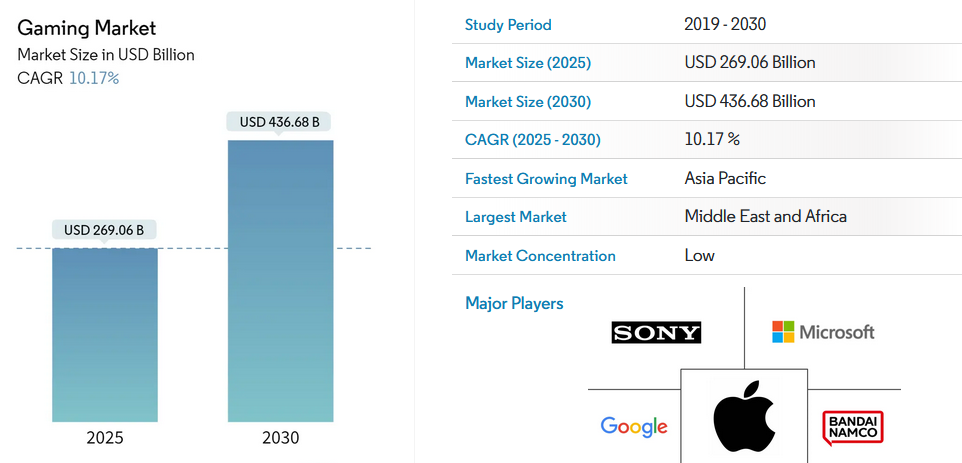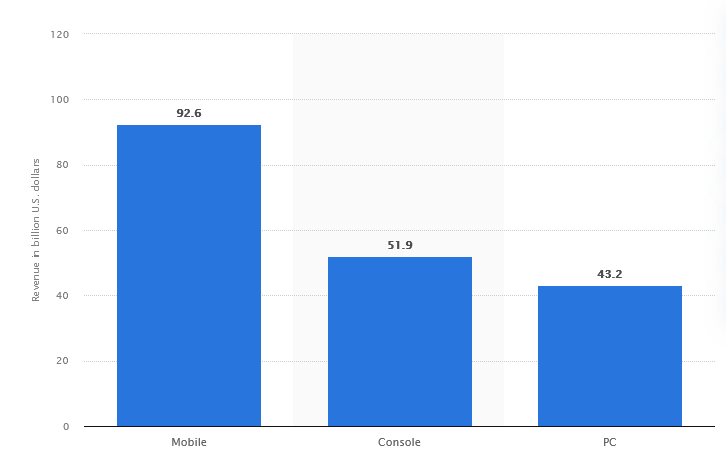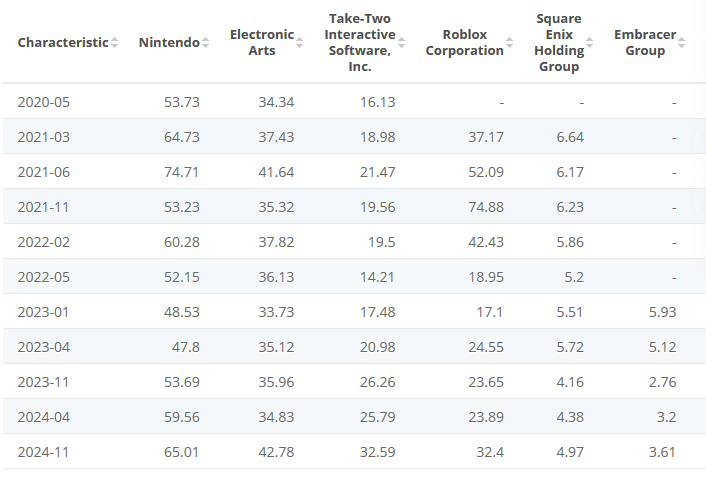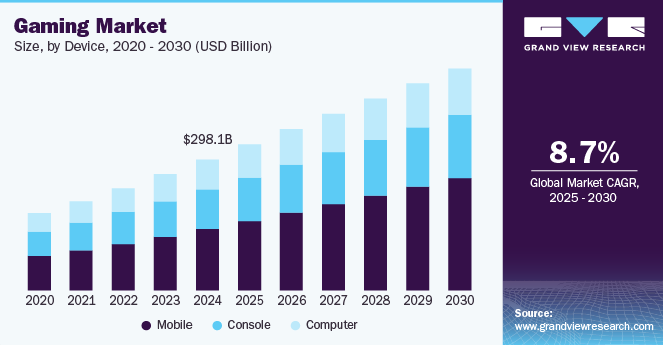As the gaming stage keeps thriving, cross-platform game development has turned into a true locomotive in 2025. For a senior in gaming or a freshman in gaming adventure, it’s a predominant choice to see how PC or console games are no longer confined to an exclusive platform. Platform game visitors instantly demand uninterrupted feelings on plenty of gadgets, from high-performance gaming PCs to consoles and even smartphones.
Herewith, this panoramic tour is crafted to disclose the veil of the cross-platform development process, why it’s needed, & how engineers produce games working continuously on multiple systems.
Our self-explaining kit has got you covered on everything you’ve wished to reveal on cross-platform game development, including the boons, key high grounds, cross-platform game engines, & prosperous cross-platform game creation.
It is clear that the gaming galaxy is rushing forward like an unstoppable locomotive. Constant AI & AR/VR innovations actuate it at every step. Cloud & mobile gaming, & e-sports discoveries add to the picture.
Take into view the blockchain that renders in-game settings more uniform—you get the pickiest gaming visitors than ever. So, cross-platform mobile games are truly the point to ride the crest in game design.
Here, you may notice a roaring urgency for cross-platform mobile game creation.
Gaming market dominance, 2025-2030, 8,7% CAGR, Grandviewresearch
To add a deeper perspective on cross-platform game development for diversified devices, in 2024, mobile gadgets occupied the topmost part in gaming globally–with nearly U.S. $92.6 billion annually, according to Grandviewresearch.
The next part is the console segment with U.S. $51.9 billion, with PC gaming standing third. It implies—the venture of crafting a game development spot is definitely worth the juice as it will produce thousands of dollars.

Let’s dive now into the specifics.
What is Cross-Platform Game Development?
So, what is cross-platform game design? It implies the course of designing & creating a game able to flee on multiple platforms with a sole codebase. Instead of creating detached versions for Windows, PlayStation, Xbox, macOS, Android, & iOS, engineers use specialized engines & frameworks for interchangeable harmony.
Cross-platform games allow visitors to enjoy a polished layout & feeling, irrespective of the hardware choice. They frequently comprise cross-progression features, warranting gamers to switch devices without losing progress.
Why Should You Choose Cross-Platform Game Development?
As game development is a domain that is gazing into futurity, developers have several ways of deciding how to build a product. Native development wraps crafting platform-aimed versions, offering optimal execution but with inflated development expenditures.
Cloud gaming is another emerging liberty, with games running remotely & streaming directly to users, eliminating hardware limitations. However, cross-platform game development stands out by hitting the perfect target between performance, attainability, & cost-effectiveness. However, cross-platform game creation protrudes by hitting the perfect target.

Perspectives of gaming sphere size for 2030, Mordorintelligence
Below are compelling arguments for why developers are advised to choose cross-platform games over other approaches. It’s absolutely binding for the diversified gaming eco-structure to pick this highway:
- Sweeping audience touch: by launching your game on multiple platforms, a startup owner immerses into a broader player base, maximizing user acquisition and retention.
- Cost & time load: a single codebase diminishes development time & cost if associated with crafting separate versions for each digital site.
- The uninterrupted feeling of play: certifies an unchanging gaming setup on all the gadgets.
- Enhanced income perspectives: occasions of ads or in-app acquisitions via augmented visitors’ volume.
- Backuping the product: as the gaming domain shifts towards cross-play methodologies, reversing multi-platform congruency turns into a full-house pick.
Key Benefits of Cross-Platform Game Development
Cross-platform game design now has a number of significant advantages:
Diminished Development Expenses
Developing a game separately for desktop, console, & smartphone can be extremely costly. A cross-platform approach enables using a single code source, reducing the development, testing, & upkeep charges.
Swifter Release Span
Since developers work on a single project rather than on multiple, they can launch the game faster across platforms. Plus, picking the cross-platform game development for mobile phones adds a shade of flexibility to your product. Look at the numbers below to see the whole perspective.
This bonus is exceptional in a hungry gaming set where time is the kernel.

Mobile gaming market income, by device, in $ billion U.S., 2024, Statista
Easier Updates & Upkeep
With a merged codebase, developers release updates, patches, and fixes simultaneously across all channels.
Enhanced Player Engagement & Retention
A cross-platform game proffers cross-play, allowing rivalries with friends, irrespective of the gaming gadgets. This enhances social interaction & retains visitors for protracted time spans.
Ameliorated Revenue Opportunities
By launching on multiple platforms, developers can recoup their resources in the game through various revenue streams, such as in-app purchases, premium versions, & advertisements. You may observe the capitalization of the hugest firms dealing with platform game design below and project this on your company’s future gains.
So, be prudent and schedule your earnings plan ahead.
As of August 2024, the U.S. media & entertainment has punched the ceiling of U.S. $649 billion, with the anticipated progression to U.S. $808 billion by 2028, with a 4.3% annual growth rate. It’s the uppermost domain, including video games & eSports.
Here’s a glimpse at international behemoths that shape the market of game development platforms.

Market сap of the predominant gaming companies, late 2024, in $ billion U.S., Statista
Now, let’s uncover the secret of cross-platform game creation.
How Cross-Platform Games Are Developed
Primarily, crafting a cross-platform gaming product entails a strategic path, employing pioneering techniques & frameworks to devise your dream product.
In addition, cross-platform capabilities must function as efficiently as possible in different software settings. Unlike sole-platform development with keeping a game adjusted to one-system specifications—such as PlayStation, Xbox, or PC—cross-platform design creates an unblemished experience of miscellaneous games across devices.
This optimizes operation, input handling, & graphical scalability with multiplayer harmony to create a uniform setting.
Cross-platform game development involves several passes, from selecting the proper game driver to fine-tuning gameplay for different digital spots. Below is a panoramic breakdown of how developers craft cross-platform games in 2025.
Picking the Suitable Game Engine
The primary step in the cross-platform storyline is selecting the proper, not just popular game engine. Some of the optimum options embrace:
- Unity—a classic for both 2D & 3D games, offering strong cross-platform upkeep & a broad asset package.
- Unreal—conventional for high-quality visual package & potent execution, this engine is widely applied in AAA rivalries & stereoscopic settings.
- Godot—open-source engine with strong cross-platform capacities & a usable screen layout.
- Cocos2d-x—best for mobile game design, presenting lightweight performance.

Above all, contact SCAND if you wish to reinforce the production cycle with game development services & raise your spirit in the local software market.
Selecting a Programming Language for Your Case
It’s pivotal to weigh for & against while designating a programming language that underpins cross-platform design. Customary alternatives encompass drivers like Unity and Unreal, so listen and heed:
- C# (Unity)
- C++ (Unreal Engine)
- JavaScript (for web-based games)
- Python or Lua (for scripting for various engines)
Cross-Platform Development Frameworks
Applying frameworks that underpin multi-platform deployment is pressing. Some options entail:
- Xamarin—magnificent for mobile & PC game design.
- Flutter—conventional for mobile and desktop games.
- Electron—employed for desktop game applications.

Optimizing Performance for Multiple Platforms
Engineers have to aim for their games to run impeccably across disparate settings by:
- Implementing adaptive graphics set-ups.
- Using cloud-based scenario save systems for fluent execution.
- Testing execution on dispersed devices to avoid lags or crashes.
Implementing Cross-Platform Features
To furnish an impeccable experience, developers should incorporate:
- Cross-play functionality endorsing contenders on multiple platforms to set tournaments & compete, regardless of the device.
- Cloud-based saves & progress syncing.
- Universal UI design that adjusts to miscellaneous layout dimensions.
Testing & Debugging
Before launch, severe testing is decisive to guarantee polished gameplay across platforms. Developers use the tools:
- TestFlight (for iOS testing)
- Android Studio (for Android debugging)
- Steamworks (for PC game testing)
- Xbox and PlayStation Dev Kits (for console congruency)
Deployment and Post-Launch Support
Once a game is tested, it’s deployed on multiple settings. Post-launch upkeep involves fixing issues, rolling out upgraded functionality, & optimizing rendering based on comments.
Choosing the Proper Instruments and Technologies for Cross-Platform Development
Picking the right tools & technologies is pressing for fruitful cross-platform game development. Cross-platform mobile game development experts should exploit characteristics such as performance, scalability, & comfortability when picking game drivers, etc.

Firstly, the weighty cross-platform game engines entail Unity and Unreal engines, spiced up with Godot & Cocos2d-x.
Secondly, programming languages are a ground to turn your game on:
- C# (Unity)—conventional for its ease & adjustability.
- C++ (Unreal)—enriching feelings with high performance, especially for visually rich tournaments.
- JavaScript (Web-based games)—perfection in browser-based and lightweight events.
- Python or Lua (Scripting)—employed for AI behavior & event mechanics.
Thirdly, development frameworks for crafting cross-platform games emerge as a final round:
- Xamarin is useable for mobile and desktop game development with C#.
- Flutter comes as a preferred selection for mobile and web-based game applications.
- Electron appears flawless for desktop-based game development.
Challenges in Cross-Platform Game Development
Therefore, cross-platform game development introduces several constraints for game design firms to surmount:
Refining Productivity
Enabling uninterrupted gameplay across devices with varying machinery capabilities. Developers implement adaptive visual settings & use efficacious coding routes, to upkeep the refined quality.
UI & UX Congruity
Variable platforms possess distinctive screen dimensions & input methods (touchscreens, controllers, keyboards). Developers need to create a user-friendly screen layout that is adaptable to all platforms without compromising the spirit of the game.
Cross-Platform Compatibility Issues
Handling different operating modes, APIs, & hardware architectures provokes congruency demurs. Herewith, applying cross-platform development tools like Unity & Unreal helps alleviate the fuss.
Networking & Cross-Play
Implementing cross-play via consoles, PCs, & smartphones requires robust networking to handle latency, harmony, & server accordance.
Platform-Specific Regulations & Store Procedures
Engineers should comply with the distinct rules on platforms to evade game pauses. These refer to certification, monetization, & data privacy.
Best Practices for Cross-Platform Game Development
To maximize the cross-platform operativity, developers should pursue these optimal routines:

Use Modular and Scalable Code
Crafting modular code holds up to efficient changes, reducing the development span while adapting the game for multiple settings.
Implement Cloud-Based Save Systems
Cloud-based systems enable you to switch devices flawlessly, no ruining game results under the belt.
Optimize Graphics & Performance
Use LOD scaling & texture squeezing that refines the game’s operation through different hardware structures.
Conduct Extensive Testing
Test the game on multiple gadgets using emulators, real-world testing, & automated debugging instruments to identify peculiar errors.
Regularly Update and Maintain the Game
Post-launch maintenance keeps your product bug-free & engaging. Retain your visitors & sustain revenue flows.
Future of Cross-Platform Game Development
The future of gaming is obviously mixed-platform. As a game development startup, listen keenly to embed these newly-born novelties in the game &, thus, stay at the crest while creating games:
Cloud Gaming Integration
Services like Xbox Cloud Gaming, Google Stadia & NVIDIA GeForce Now are reshaping how players access games. Developers will increasingly integrate cloud streaming to eliminate hardware constraints.
AI-Driven Tournaments’ Improvement
AI-powered tools will automate game balancing, asset generation, & player behavior analysis, revamping cross-platform workflows.
Blockchain with NFT Integrations
More to add, blockchain bailiwick and play-to-earn (P2E) schemes commercialize in-game sources, offering cross-platform ownership of articles.
More Cross-Play & Cross-Progression Features
As player demand for uninterrupted feelings inflates, more games adopt cross-play matchmaking and cloud-based syncing across devices.
Augmented and Virtual Reality (AR/VR) Expansion
The rise of AR & VR in gaming tournaments pushes creative engineers to work with & visualize immersing feelings across cross-platform, bridging mobile, PC, and VR headsets.
Why Choose SCAND for Cross-Platform Game Development?
Let’s start from the ground. If you wish to select the software expert able to perform any exquisite task on multiple platforms and render your clients satisfied and glad about the accomplishment, turn to SCAND.
Our 25+ years-long expertise will convert the most sophisticated conception to existence, with top-notch competencies & communication skillset under the belt.
In the game & gambling development area, we’ve shaped a whole route, thus furnishing our customers with full-stack cooperation on:
- Mobile games & app development. Developing game apps – from concept to post-launch support, we guarantee steady game performance without a hitch.
- There, the SCAND team developed this educational KidsGame product for children’s joy and benefit. The app was crafted using Java, C/C++, & Objective-C technologies, to be flawlessly played on iOS & Android platforms.

KidsGame, an Educational Mobile App for children by SCAND
- Custom Cross-Platform Solutions. With suitable game drivers, scalable architectures, & integrations for software products, our experts brilliantly tackle all sorts of sophisticated tasks.
- AI-Proven Solutions. We exploit & exquisitely embed methodologies of predictive analysis, NLP, & computer vision into the gaming development software to hoist the operation & render the poised use of our software.
- Sports Betting App Development. In this area, our crew embraces multifaceted kinds of sports in one gaming product – like horse or golf betting.
- Blockchain Game Development. This profitable section involves crafting P2E tournament integration, crafting in-game tokens, services on embedding wallets, creating NFT tradings, etc.
FAQs on Cross-Platform Game Development
What Are the Key Benefits of Cross-Platform Game Development?

Wrapping a cross-platform building stands as the tomorrow of gaming as of 2025. With fitting tools, frameworks, & development methods, game design engineers shape engaging, high-quality products with optimum practices on top. Gaming engineers future-proof gaming products, also staying rivalrous in the terrain.
Thus, via crafting & employing a single code source for multiple settings, gaming engineers diminish caseload, prune updates, & propose gameplay harmony across devices.
This way, demurrers of multi-platform compliance may be bridged & parcelled across PC, consoles, & smartphones.
How Long Does It Take to Develop a Cross-Platform Game?
The game-to-market timeline fluctuates, based on elements such as game proficiency, the number of team participants, & chosen technologies with a target platform. A basic 2D game can occupy a few months, while a pioneering 3D multiplayer tournament may take several years. Leveraging cross-platform game engines and pre-built assets can speed up the process, but thorough testing across devices remains a crucial phase.
What Platforms Can Cross-Platform Games Be Developed For?
Modern cross-platform development allows games to be built for PC (Windows, Linux), mobile devices (iOS, Android), consoles (PlayStation, Nintendo Switch, Xbox), & even web browsers. With cloud gaming services like Google Stadia, Xbox Cloud Gaming, & NVIDIA GeForce Now, developers can also optimize games for streaming-based experiences.
How Do I Choose the Right Game Engine for My Cross-Platform Game?
Handpicking the fitting engine relies on your game’s genre, target platforms, & productivity necessities:
- Unity—terrific for 2D & 3D tournaments, supports mobile, desktop, consoles, & AR/VR.
- Unreal—well-suited for high-end graphics, AAA events, etc.
- Godot—a lightweight, open-base engine for indie developers.
- Cocos2d-x—a proper pick for mobile and 2D events. Mind up the learning line, operativity capabilities, & licensing charges.
What Are the Cost Implications of Cross-Platform Game Development?
The cross-platform development cost depends on the game’s ampleness, features, & technical ground. Key expenses encompass:
- Obtaining game engine licenses. Some engines are available for free tiers but charge fees for trade-related releases.
- Development team payback. Hiring programmers & testers adds to your check.
- Testing & refining. To certify the game runs effortlessly across all platforms requires additional resources.
- Post-launch support. Continuous updates, patches, & marketing inflate long-term costs.

